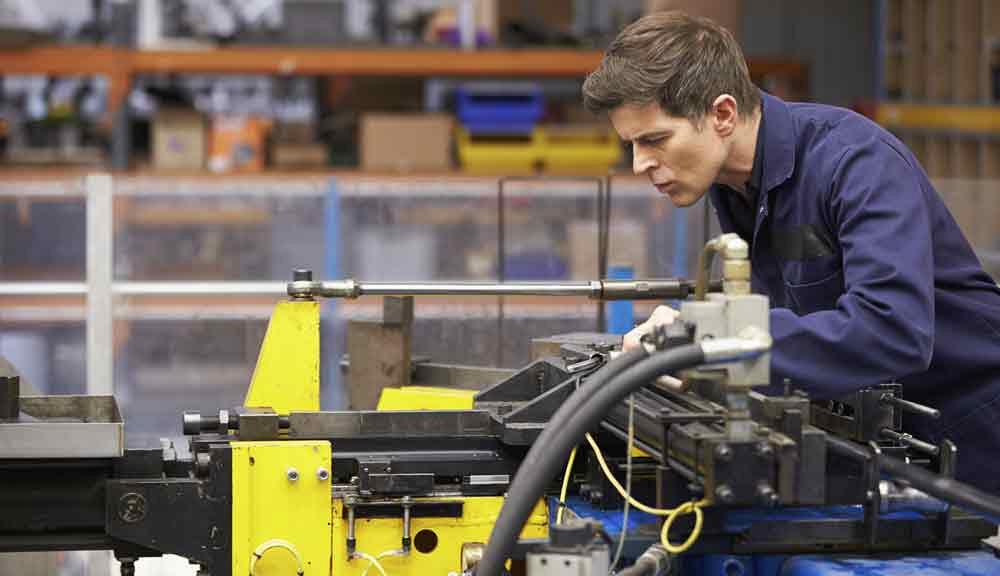Owner
- FMA
- The Fabricator
- FABTECH
- Canadian Metalworking
Categories
- Additive Manufacturing
- Aluminum Welding
- Arc Welding
- Assembly and Joining
- Automation and Robotics
- Bending and Forming
- Consumables
- Cutting and Weld Prep
- Electric Vehicles
- En Español
- Finishing
- Hydroforming
- Laser Cutting
- Laser Welding
- Machining
- Manufacturing Software
- Materials Handling
- Metals/Materials
- Oxyfuel Cutting
- Plasma Cutting
- Power Tools
- Punching and Other Holemaking
- Roll Forming
- Safety
- Sawing
- Shearing
- Shop Management
- Testing and Measuring
- Tube and Pipe Fabrication
- Tube and Pipe Production
- Waterjet Cutting
Industry Directory
Webcasts
Podcasts
FAB 40
Advertise
Subscribe
Account Login
Search
Safe and round with tube and pipe handling?
Tube and pipe fabricators often take safety risks that wouldn't fly in other facilities
- By Douglas Raff
- August 4, 2015
- Article
- Safety

Figure 1
The round shape of tube and pipe makes it easy to move
material, but it also can present a danger if the right controls
are not being used.
Awareness of the hazards associated with press brakes and stamping presses has improved dramatically over the last decade. An emphasis on having a low workers’ compensation insurance modification factor as a prerequisite to winning contracts with FORTUNE 500 companies, the technological improvements in the safeguarding devices used to guard brakes and presses, and the Occupational Safety and Health Administration’s enforcement of CPL 2-1.24 National Emphasis Program on Mechanical Power Presses have all been contributing factors.
The same cannot be said for the tube and pipe industry. Operational hazards similar to those in general fabricating can be found in the manufacturing of tube and pipe, yet safeguarding devices are not always in use, or they are bypassed and circumvented. For those working in an environment where tube and pipe is produced or fabricated, the dangers have not been made so apparent, and operators are regularly required to put themselves in harm’s way, relying on company-established administrative safety measures and their own skills to prevent injury.
Unlike flat metal, pipe and tube are round and they don’t have burrs and sharp edges. When straight, their shape allows gravity, a very affordable energy source, to be used regularly to move them around the shop (see Figure 1). On the downside, these parts are tough to stack and, once formed, become a handling and storage problem.
Tube and pipe operators tend to work with long lengths. During the forming process, operators are exposed to parts whipping around on a bending machine. As parts grow in size, so does the working area. Unsuspecting workers that are not prevented from entering the working area during a job could be in extreme danger of being hit by the tube as it is being formed. Additionally, each piece must be placed into a clamp, exposing the operator to a pinch point every time (see Figure 2).
As in any manufacturing scenario, safety enhancements can turn an operation with frequent exposure to potential harm into an operation with significantly less exposure to these hazards. It’s just a matter of making the right choices. The following hypothetical scenarios provide an idea of just how operator risk can be reduced with commonsense risk analysis and an investment in implementing the right safeguarding devices and improvements to the manufacturing processes.
Scenario No. 1: The Gravity-fed Pipe Handling System
In this production facility, flat steel comes off a coil and is formed into pipe. The pipe mill produces varied sizes of product, with the largest being 40 in. in diameter trimmed into 60-ft. lengths and having a wall thickness of 0.625 in. It’s big and heavy stuff.
The pipe production process is enclosed by mechanical barriers and fencing. Access to the working area is only through interlocked gates. When a gate is opened, its interlock prevents the line from operating. Once the gate is closed, a local reset button must be pressed, indicating that the area is clear for the line to be started again. For the most part, the operation is well-guarded, and automation helps to reduce the risk of injury. The pipe handling situation in the inspection area is another story.
When the pipe is fully formed and trimmed to length, a gravity-fed material handling system takes over. It moves the pipe into place against retractable stops for inspection. Because of the length of the pipe, two individuals handle inspecting chores, working their way down the pipe from each end. Once the pipe passes inspection, one of the operators presses a button to advance the pipes from the inspection stage to the storage area. Simultaneously, the next pipe is allowed to advance to the inspection station.
Notice anything unsafe with this scenario? Two inspectors and one button to advance pipes in a gravity-fed material handling system?
It is apparent that these two people have a system where one gives an OK signal and the other hits the button to move the pipes along. That type of system totally relies on the awareness of the operators and has no safeguard against human error. What if one of the inspectors is waving away a fly, and the other inspector takes that as the OK to feed the pipes forward? A gravity-fed system unfortunately doesn’t come with instantaneous stops.

Figure 2
Having an operator this close to the clamping and moving end of a tube bender while it is on is not an acceptable work practice for any facility.
The best scenario for improvement is to automate the inspection process. By eliminating the tasks that put the operators into the working area, the hazards associated with those tasks are eliminated. However, vision systems are expensive and are less intuitive than the human eye.
To allow the operators to continue their inspection tasks and reduce the level of exposure to the crushing hazard, the company should implement a combination of engineered and monitored administrative measures. First, safety laser scanners can be put in place to ensure the area is clear before the pipe is advanced to the next station. Second, a second operating station could be added requiring concurrent action by both operators to advance the pipe. This approach ensures both operators are aware of what is happening and eliminates the chance that shooing a fly would be construed as the signal to advance the pipe.
Scenario No. 2: The Improperly Guarded Tube Bending Cell
In this fabrication facility, company management appears to have made an effort to comply with the ANSI B11.15, Safety Requirements for Pipe, Tube, and Shape Bending Machines, which is available from the Fabricators & Manufacturers Association’s online bookstore (http://ebiz.fmanet.org/Ebusiness/). A safety laser scanner is installed at the base of a horizontal tube bender. The unit appears to be positioned in such a way that this electronic floor mat prevents the machine from operating when an operator is inside the working area.
A closer inspection shows, however, that the safety zone of the laser scanner has been reprogrammed to scan an area so small that the operator is able to operate the tube bender standing right up against the edge of the machine. Upon being questioned, the operator indicates it is the only way he can hold the part in place while clamping. Once the tube is clamped, he then moves out of the working area and initiates the bending process.
The safety device has been set up in such a way that it does not provide even the basic protection from the pinch point between the clamping device and the tube. Nor is it providing any protection for the bending part of the operation, the hazard it was originally meant to mitigate.
The irony of the situation is that the most useful feature of a safety laser scanner is that it can be easily reprogrammed to accommodate changes to a working area. For instance, if a table is brought into an operation to support a large tube, the scanner can be taught to accept the table as belonging in the safeguarded area. If something other than the recognized table enters the working area, the safety laser scanner shuts down the machine’s operation.
While management has done the right thing by adding the safeguarding device, it has failed to implement any changes to the operational process to accommodate the addition of the safety device. In this case, adding a part manipulator along with the safety laser scanner would have enabled the operator to place the part into the clamps and operate the bender all from a safe area outside the working zone.
The key to keeping the operator safe in this tube bending operation—and, frankly, any metal fabricating activity—is to improve the operating procedure so that the process works within the safety devices’ protective boundaries. A safeguard should be easier to work with than around!
Staying Productive and Safe
Safeguarding has become less intrusive on the manufacturing process than it was a decade ago. Technology advancements and the adoption of lean manufacturing principles have helped to keep the shop floor running efficiently and improve workers’ safety. Despite what some fabricators may think, safety doesn’t have to be a drag on shop floor productivity.
That is particularly true for those niche areas of fabricating, such as tube and pipe, where the OSHA focus may not be as frequent or strong, but the hazards to the operator are often encountered and serious. Old-school fabricators put employees at risk in the name of dated manufacturing practices. Today’s manufacturers have access to production-friendly safeguarding technology and lean manufacturing practices that not only make operations safer, but also make them more efficient and profitable.
A tube and pipe fabricator or producer that hasn’t had any incidents related to unguarded operations isn’t being safe, it’s just lucky.
About the Author
Douglas Raff
18001 Irvine Blvd., Suite 202
Tustin, CA 92780
714-564-9925
subscribe now

The Fabricator is North America's leading magazine for the metal forming and fabricating industry. The magazine delivers the news, technical articles, and case histories that enable fabricators to do their jobs more efficiently. The Fabricator has served the industry since 1970.
start your free subscription- Stay connected from anywhere

Easily access valuable industry resources now with full access to the digital edition of The Fabricator.

Easily access valuable industry resources now with full access to the digital edition of The Welder.

Easily access valuable industry resources now with full access to the digital edition of The Tube and Pipe Journal.
- Podcasting
- Podcast:
- The Fabricator Podcast
- Published:
- 04/16/2024
- Running Time:
- 63:29
In this episode of The Fabricator Podcast, Caleb Chamberlain, co-founder and CEO of OSH Cut, discusses his company’s...
- Industry Events
16th Annual Safety Conference
- April 30 - May 1, 2024
- Elgin,
Pipe and Tube Conference
- May 21 - 22, 2024
- Omaha, NE
World-Class Roll Forming Workshop
- June 5 - 6, 2024
- Louisville, KY
Advanced Laser Application Workshop
- June 25 - 27, 2024
- Novi, MI































